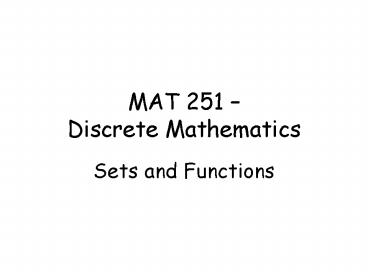MAT 251 Discrete Mathematics - PowerPoint PPT Presentation
1 / 17
Title:
MAT 251 Discrete Mathematics
Description:
MAT 251. Discrete Mathematics. Sets and Functions. Section 2.2 ... The union of the sets A and B, written A U B, is the set that ... A B AND B A. OR ... – PowerPoint PPT presentation
Number of Views:86
Avg rating:3.0/5.0
Title: MAT 251 Discrete Mathematics
1
MAT 251 Discrete Mathematics
- Sets and Functions
2
Section 2.2 Operations on Sets
- Def Let A and B be two sets. The union of the
sets A and B, written A U B, is the set that
contains elements that are either in A or in B,
or in both. - A U B x x ? A or x ? B
B
A
U
3
Section 2.2 Operations on Sets
- Def Let A and B be two sets. The intersection
of the sets A and B, written A ? B, is the set
that contains elements that are in both A and B. - A ? B x x ? A and x ? B
4
Section 2.2 Operations on Sets
- Note When the intersection of two sets is the
empty set, we say that the two sets are disjoint. - Example Let A a, 2, 3 and B 1, 5.
- Then A and B are disjoint, so A ? B Ø.
5
Section 2.2 Operations on Sets
- Example Suppose U N
- Let A 1, 2, 4, 51, 59, 60, 100, 250,
- B 2, 4, , 50 and C 1, 51, 59. Find
- a) B U C
- b) A U C
- c) A ? C
- d) A ? B
- e) B ? C
6
Section 2.2 Operations on Sets
- The Principle of Inclusion Exclusion gives
- A U B A B - A ? B
7
Section 2.2 Operations on Sets
- Def Let A and B be two sets. The difference of
A and B, written A - B, is the set that contains
elements that are in A but not in B. Also, called
the complement of B wrt A. - A - B x x ? A and x ? B
8
Section 2.2 Operations on Sets
- Def Let U be the universal set. The completment
of the set A, written Ac is the set that
contains elements that are in U and not in A.
The complement of A is the set, U-A. - Ac x x ? A
U
A
9
Section 2.2 Operations on Sets
- Set Identities Page 124
- 1) Identity Law
- 2) Domination Law
- 3) Idempotent Law
- 4) Complementation Law
- 5) Commutative Law
- 6) Associative Law
- 7) Distributive Law
- 8) De Morgans Law
- 9) Absorption Law
- 10) Complement Law
10
Section 2.2 Operations on Sets
- How do we prove that two sets A and B are
equal? - 1) Show A B iff A ? B AND B ? A.
- OR
- 2) Use the set builder definitions and show
equivalence that way.
11
Section 2.2 Operations on Sets
- Prove that A U B B U A.
- Pf We will show this by showing that
- A U B ? B U A and B U A ? A U B.
- First, suppose x ? A U B. Then by definition x
? A or x ? B. Since disjunction is commutative,
we can say that x ? B or x ? A. So, by the
definition of union we have that - x ? B U A. So, indeed A U B ? B U A.
- Next, suppose that x ? B U A. Then by
definition - x ? B or x ? A. Since disjunction is
commutative, we can say that x ? A or x ? B. So,
by the definition of union we have that - x ?A U B. So, indeed B U A ? A U B.
- So, since each set is a subset of the other we
have shown that the two sets are equal to each
other.
12
Section 2.2 Operations on Sets
- Prove that A U B B U A.
- Pf We will show this using the following
steps. - A U B x x ? A or x ? B
- x x ? B or x ? A
- B U A.
13
Section 2.2 Operations on Sets
- Def Membership table are similar to truth
tables and are set up in the same way. We can
demonstrate that an element is in a set by using
a 1, and to indicate that an element is not in a
set by using a 0. - We can prove set identities using membership
tables as well, very similar to proving logic
rules.
14
Section 2.2 Operations on Sets
- Show that (A ? B ? C)c Ac U Bc U Cc
15
Section 2.2 Operations on Sets
- Def The union of a collection of sets is the
set that contains those elements that are members
of at least one set in the collection. Notation - The intersection of a collection of sets is
the set that contains those elements that are
members of all the sets in the collection.
Notation
16
Section 2.2 Operations on Sets
- Do Page 131/45
17
Section 2.2 Operations on Sets
- The notes have been created with the use of
Discrete mathematics and Its Applications, Sixth
Edition by K. H. Rosen































